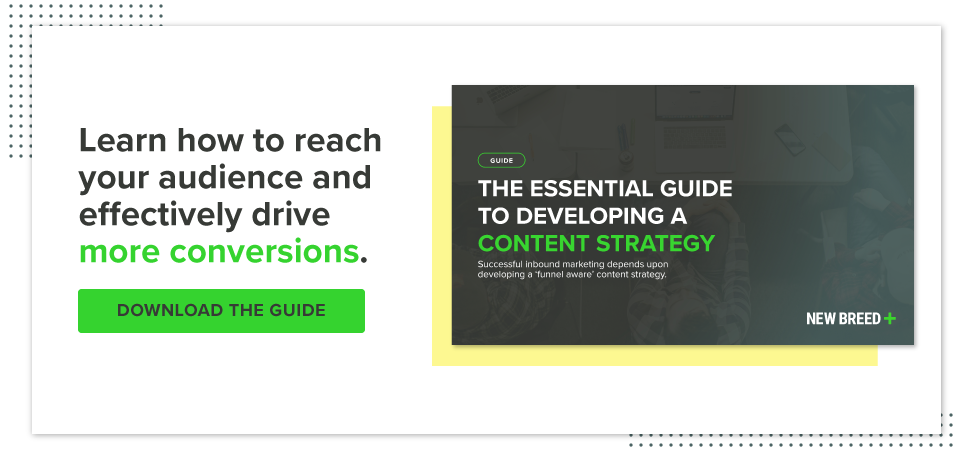7 Pillar Page Best Practices to Enhance UX and Boost SEO Success

What’s the purpose of a page on your website?
Ultimately, the purpose of your pages should be to help your visitors, giving them the best experience possible and adding value throughout their journey.
Today, a new way to produce and organize content has formed. It not only facilitates a great user experience, providing a logical layout for your content, but it also can help your material rank well in organic search results.
It’s known as a pillar page.
What’s a Pillar Page?
“The point of a pillar page is to take a topic that has a vast amount of information about it and distill that topic to a bird’s eye, broad understanding of it,” says New Breed’s Lead Search Strategist, Rider Gordon.
Effective pillar pages don’t exist independently on your site. They need to be connected with other site content in a logical way. That’s why pillar pages go hand-in-hand with topic clusters. A topic cluster is an organizational map where a core idea and corresponding points are linked, creating comprehensive coverage of a subject.
To build a pillar page, “You need to identify a long-tail, high-volume keyword that covers a topic as a whole,” says Rider.
For instance, take the term lead generation. There are hundreds of subtopics surrounding lead generation. To create a pillar page around the term, it’s best to write about as many of those subtopics that are relevant and logically connect to the core. You might not go into much detail on every topic, but you should at least touch on them. Your ultimate goal is to create a page that offers a one-stop-shop to learn about your topic of choice.
Then, you should build cluster content around the pillar, individual blogs that discuss the subtopics of your main subject. In our example, those pages would discuss subtopics around lead generation, such as the customer lifecycle, content marketing and form strategy. Then, you should link the cluster content to the pillar and the pillar to the cluster content, creating a comprehensive content network.
.png)
Of course, there are many different strategies that can be applied to build a pillar page so we’ve compiled a list of best practices.
7 Pillar Page Best Practices
1. Find the ideal length for your pillar page
To find the ideal pillar page length, you need to maintain a balance between including enough material to optimize your page for search and keeping your content succinct enough that you don’t overwhelm your readers.
“The best practice I’ve found is between 2,000 to 5,000 words, and I think 3,000 words is probably the sweet spot,” says Rider.
While more content is certainly fine, you want to be conscious of your readers. If you intend to give them a digestible piece of content, publishing a longer piece is probably ill-advised. Ask yourself: Is this distilled down to the best piece of content possible?
2. Hit the right search volume for your pillar keyword
To build a pillar page, you need to find the right term to use. You want to strike a balance with the search volume of that term, ensuring it has enough volume to maintain consistent traffic but not too much that it becomes convoluted.
“The term should maintain a minimum of around 400 searches per month,” says Rider. “With anything below that, I think you need to start thinking about whether it’s worth the time invested for the volume of users searching that term, let alone coming to your site.”
Ultimately, you need to think about the upper range of your term’s search volume as well. You don’t want to target a keyword that is too vague. For example, according to SEMrush, “customer service” has a monthly volume of 165,000. This is too broad a term to target.
3. Identify your subtopics
To find a core term to write about, Rider combs through a client’s content library and looks into the terminology they’re using, searching for an all-encompassing keyword with decent search volume that warrants building a page around.
Once he locates a keyword, Rider says he defers to experts in the field to identify subtopics.
“I think that the client is much more experienced and knows far more than I do about any topic relevant to their business,” he says. “I like to have a conversation with the client or have the content team have a conversation with subject matter experts about that term.”
From there, ask the experts to list out all of the potential subtopics they can think of surrounding the subject. For example, if the term was inbound marketing, the expert might identify words like SEO, email marketing and web design.
At that point, it’s about trying to determine the best keyword that fits within that subtopic and writing blog posts concentrating on those terms.
“And then, working with the content team, working with that subject matter expert, let’s take a look at your subtopics and identify the types of blog posts around those terms that would be relevant for your personas,” says Rider.
For example, if one of your subtopics is about email marketing, writing a blog post about, “The Best Email Marketing Practices to Leverage This Year” could attract the right visitors to your site.
4. Present your content in a logical framework
“The way I like to envision a pillar page is aligned with the buyer’s journey,” says Rider. “I like to break down [the page] into the awareness, consideration and decision stage framework.”
Continuing with our inbound marketing example and using the framework that Rider described, the first section should outline awareness stage material where visitors might be asking questions like “what is inbound marketing?” to strengthen their understanding of the subject.
“You’re going to have an H1 or H2 that says ‘What is Inbound Marketing?’ and then under that what we like to do is optimize for featured snippets… that’s the first structural piece we optimize for,” Rider continues.
Including a definition of what inbound marketing is and consolidating it to fit within 45 words — the average length for a featured snippet — could help you capture position zero on Google.
In the awareness section, you could explain other introductory material about inbound marketing, detailing why it matters, how it’s different from outbound marketing and other definitional material.
Once you reach the consideration stage, you can begin to discuss your subtopics. At this point, your readers should know that there are different inbound marketing tactics that can be leveraged, so you can teach them how to use them. Revisiting the subtopics mentioned earlier, you could discuss SEO, email marketing and web design, among a host of other topics.
From there, you can transition into the decision stage. If your visitors understood the inbound methodology, why different tactics are important and how those tactics are carried out, you could introduce them to different tools or services that would help them accomplish inbound marketing. At this point, you would want to begin positioning your company as a solution to their problems.
Overall, you want to ensure your content is providing value to your customers, so you don’t want to sound too much like a salesperson at the very end of your page. However, as long as you are providing value and helping your customers, guiding their thought process to align with your solution is wise.
“There’s certainly types of pages that don’t leverage the awareness, consideration, decision stage framework, but I’ve found [ones that do] to be the most successful, at least in my experience,” says Rider.
5. Offer a downloadable version of your page
Generally, we believe all of your pillar page content should remain ungated. While pillar content often takes a long-form structure similar to a guide, you should leverage it to rank via organic as opposed to hiding it behind a form.
However, for the sake of user experience and lead generation, it can be wise to offer a downloadable version of your page. This way users can download the page and digest it in an offline format.
6. Include a table of contents
Including a table of contents on your pillar page is often a good idea. It can help improve user experience, allowing visitors to hop around to different sections of your page without having to scroll and search.
“From a design aspect, I think it’s really helpful to have a sticky navigation that follows a user down the page,” says Rider.
Having that table of contents readily available no matter where a reader is maximizes the value visitors can gain.
7. Ensure your pillar owns the most link equity
If your pillar page is about inbound marketing, you need to ensure it is the page on your site with the most link equity for that subject.
Consider a scenario where you have many blog posts about different aspects of inbound marketing. Ideally, you want most or all of those blogs to link to and receive links from your pillar page as long as they are contextually relevant. You also want search engines to know that your inbound marketing pillar page is the main resource on your site for that topic.
For simplicity’s sake, if your pillar had three links pointing to other pages, you would want to make sure that there were more than three links at the very least directing back to the pillar. You want to make sure there are more links flowing to your pillar than from your pillar, signaling to search engines that it is your main resource on the topic.
Additional best practices
We also suggest following these helpful pillar page practices:
- Make your content scannable by using clear H2s, blockquotes, bulleted lists and short paragraphs
- Ensure your pillar doesn’t look like a landing page. You should have text above the fold to draw your visitor into reading more
- Always make sure that links off from your pillar page open in new tabs so you aren’t sending people off your site or cutting their session short.
- Be mindful of including external links on your page. They can provide good trustmarks for visitors and Google, but to emphasize user experience, ensure you make the link destination as evident as possible. You don’t want to interrupt visitors by having them click a link that brings them to a page that they weren’t expecting.
Key Takeaway
Pillar pages should help you optimize your SEO efforts. They’re a great means to climb SEO rankings and deliver a logical content organization for web crawlers to understand. Ultimately, however, they should help your visitors learn more about the topic you’re writing about.
You shouldn’t sacrifice users’ experience on your site to reinforce your SEO ranking. Instead, you should provide a digestible piece of content that educates your visitors and offers value every step of the way. Only then will you realize the value of pillar pages.
Isaac Desranleau
Isaac is an Inbound Specialist at New Breed. His passion for the inbound philosophy of giving value to customers before extracting it brought him to New Breed. In his free time, he's an avid outdoorsman.





